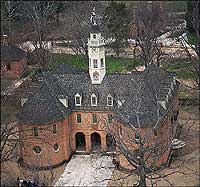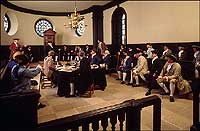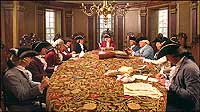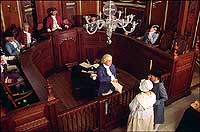Page content
Capitol

- Fire destroyed Jamestown statehouse three times
- Government moved to Williamsburg
- Constructed by contractor Henry Cary, who built Wren building at College of William & Mary
- Men who gathered here May 15, 1776 spoke for American independence
- Current building third on the site
- Naturalization ceremony held once a year
Virginia first colony to speak for independence
The first colony to speak for American independence, Virginia spoke with the unanimous voices of the gentlemen who gathered May 15, 1776, in the tall brick building that dominated the east end of Williamsburg. From what had been England's original New World possession, Virginia instructed its delegation at Philadelphia's Continental Congress to move the question of freedom. Thomas Jefferson's Declaration of Independence records the Continental Congress's answer.
The gentlemen at Williamsburg sat in the oldest representative assembly in what was now the world's newest nation. The legislature first met at Williamsburg on April 21, 1704, when the Capitol on Duke of Gloucester Street was still under construction. Literally and figuratively, however, its foundation dated to 1619, when the House of Burgesses first convened at Jamestown.
Colony government moved to Williamsburg
After fire destroyed (for the third time) the Jamestown Statehouse in 1698, the burgesses decided to move the colony's government to Middle Plantation, soon renamed Williamsburg. On May 18, 1699, they resolved to build the first American structure to which the word "Capitol" was applied.
Henry Cary, a contractor finishing work on the College of William and Mary's Wren Building (the legislature's temporary home) took charge. He raised a two-story H-shaped structure – really two buildings connected by an arcade. Each measured 75 feet by 25 feet; their south ends terminated in semicircular apses penetrated by three large round windows.
The first floor of the west building was for the General Court and the colony's secretary, the first floor of the east part of the building was for the House of Burgesses and its clerk. Arched windows marched across the facades.
Stairs on one side led to the Council Chamber, a lobby, and the Council clerk's office; stairs on the other side led to three committee rooms. A second-floor conference room connected the classically corniced structures, and a six-sided cupola on the ridge of the hipped and dormered roof crowned it all. Though the west wing was completed by July 1703, it took Cary until November 1705 to finish all the work.
Today's Capitol third on the site
The building that stands today is substantially the same as Cary's, but it is the third Capitol on the site. To blunt the threat of fire, Cary's Capitol was built without fireplaces. Candles and pipes were barred. But in 1723, the secretary complained that the building was damp, so chimneys were added for fireplaces to help keep the Capitol dry. Between 7:00 and 8:00 a.m. on January 30, 1747, someone noticed that the building was burning. When the flames died, only some walls and the foundation remained.
In March, Governor William Gooch urged that the Capitol be rebuilt, but many legislators preferred moving the government to a city more accessible to trade and navigation. In the meantime, the burgesses met at the Wren Building. The General Court took up residence in City Hall – a building that had a few years before served as the first theater in America. When a vote was taken on November 23, 1748, reconstruction of the Capitol was approved by two votes: 40 to 38.
John Blair wrote in his diary on April 1, 1751, that he had laid a foundation brick for the second Capitol. On December 12 he put a brick atop a finished wall. The south ends of the new structure were squared, and the western entrance got a two-story porch that more plainly designated it as the main entrance. The burgesses met inside for the first time on November 1, 1753.
Historic events in American history occurred here
In this building Patrick Henry delivered his "Caesar-Brutus" speech against the Stamp Act on May 29, 1765. Henry, George Washington, George Mason, George Wythe, Richard Henry Lee, Jefferson, and others played their parts in the legislative wars that ended in revolution.
There were lighter moments. Both Capitols were the scenes of dances, suppers, and other social events. But as fighting erupted in the North, the building rang to the debates over Mason's Declaration of Rights, his Virginia constitution, and Jefferson's first attempt at a bill for religious freedom.
The building was last used as a capitol on December 24, 1779, when the General Assembly adjourned to reconvene May 1 at the new capital, Richmond. By turns the building served as an admiralty court, a law school, a military hospital, a grammar school, and a female academy. The west wing was sold for its bricks and demolished in 1793; the east burned in 1832. In 1881 the last aboveground traces of the Capitol were removed from the lot.
The Association for the Preservation of Virginia Antiquities deeded the grounds to Colonial Williamsburg in 1928, and Colonial Williamsburg reconstructed the Capitol of 1705 – 1747. The architecture was more interesting than that of the second Capitol, and it was better documented.
Virginia General Assembly dedicated current building in 1934
Refurnished with the help of 18th-century records, the new Capitol was dedicated with a ceremonial meeting of the General Assembly on February 24, 1934. Since that time, the legislators have reassembled for a day every other year in the tall brick building at the east end of Colonial Williamsburg's Historic Area.
Immigrants become American citizens in annual naturalization ceremony
Every day, visitors of all ages tour the Capitol to learn about government in colonial Virginia and the colony's contribution to the American Revolution. Evening programs feature both the political events that occurred in the building during the 18th century and the social events held there. Once a year, a naturalization ceremony is held at the Capitol, during which a new group of immigrants becomes Americans, continuing a process begun in the building nearly 300 years earlier.


